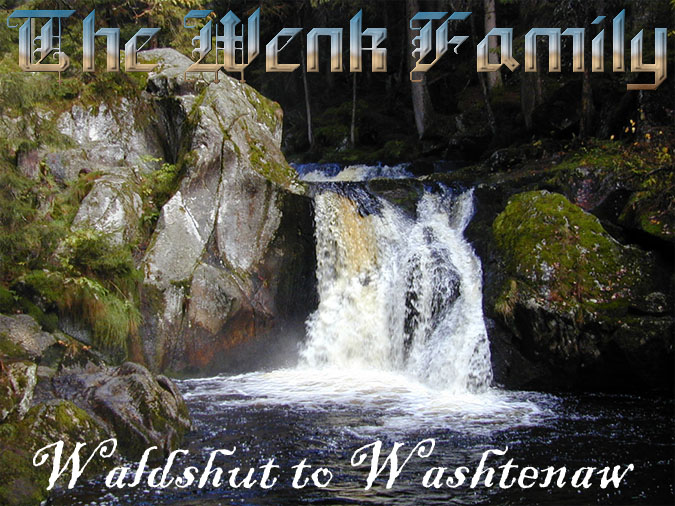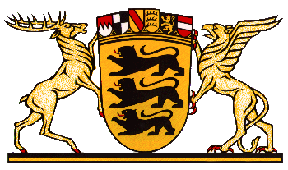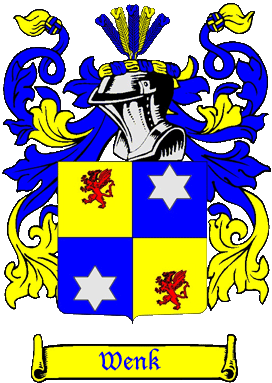 |
 |
One of these German families, the Wenks, first arrived in "the best poor man's country" during the second wave, in the person of IGNATZ WENK, sailing from Baden.
The Wenk family surname traces back almost a thousand years in Europe. Variations on the name include Wenckh, Wenck, Wening, Weniger, Wenin, Wenig, Wenisch, Wenk, Wenger, Wenge, Weining, Wiening, Weuning, Wauning and many more, as well. But it seems to have first appeared in Bavaria, where the family was connected with the many tribal conflicts of the area throughout its long history.
Our Wenk line is 'Swabian' (Schwäbisch in the German language), coming from the Grand Duchy (Großherzogtum) of Baden, in what is now the Black Forest (Schwarzwald) in Germany. This beautiful land covered the eastern half of the fertile valley of the Rhine, with a majestic range of mountains forming its boundary.
 "Schweigmatt Gersbach and the Rhine Valley Black Forest," a 2002 painting by Ernst Wenk (10 Apr 1923 - 23 May 2011). Much of the information on this site is based on his genealogical work. Ernst's line of the family is Swiss, and he was working to connect the German and Swiss Wenks to a single ancestral point (our earliest known Wenk ancestors were from different countries but lived about 40 miles from each other). You can read his entire family history here.¹ |
 |
With this in mind, the Wenk name could derive from the Low German and Frisian personal name Weneke, a short form of any of the compound names beginning with the Old High German element wini (‘friend’). But sometimes it was also used as a topographic name for someone who lived by a turning or bend, as the Middle High German wenke. Then there's the Middle Low German wenneke or ‘wide woolen dress’, so it could have been an occupational name for a maker or seller of such garments. We can only hope that our family doesn't derive from the Middle High German nickname wenken, meaning ‘to stagger or waver’, probably applied to someone with a peculiar gait, or to a drinker, or to someone who was indecisive (although all three could apply to this writer).
On the family coat of arms, the blue in the family crest is the color of loyalty and truth; the yellow stands for generosity. The squared and quartered shield features two griffins, signifying the property of a valorous soldier who "dared all dangers, and even death itself, rather than become captive." The two six-pointed mullets point to a Divine quality bestowed from above. The panache of feathers symbolizes willing obedience and serenity, and the closed helmet, in profile beneath, denotes an esquire or private gentleman.
To read all about our loyalty, truthfulness, generosity, valor, daring, Divinity, willing obedience and serenity, and follow our ancestors from the Black Forest of Germany, to the wilds of 19th Century Michigan, to the weirdness of 21st Century California, click on the chapters below:
|
CHAPTER 1: WENKS FROM FROM BADEN TO WORSE, 1705 - 1849 CHAPTER 2: IGNATZ WENK, 1850 - 1997 CHAPTER 3: MARTIN WENK, 1876 - 1962 CHAPTER 4: ERWIN WENK, 1910 - 1982 CHAPTER 5: THE WENK FAMILY TODAY, 1940 - PRESENT
APPENDIX A: WENK FAMILY REUNIONS, 1923-PRESENT APPENDIX B: CENSUS REPORTS, 1870 - 1950 APPENDIX C: FAMILY TIMELINE, 1700-PRESENT |
NOTES ON THIS PAGE:
¹—Ernst Albert Wenk (Ernst,¹² Ernst,¹¹ Samuel,¹⁰ Hans Georg,⁹ Johannes,⁸ Johannes,⁷ Hans,⁶ Hans,⁵ Hans,⁴ Johannes,³ Philipp,² Philipp¹) was born on 10 Apr 1923 in Riehen, Kanton Basel-Stadt, Switzerland. He was a painter, scholar, teacher, youth project director, clinical psychologist, research center director at UC Davis, writer, and (obviously) a genealogist. Ernst married (1) Bertha Schaub (1923-1992) on 19 Jul 1945 in Basel, Kanton Basel-Stadt, Switzerland. They had two children: Christoph Johannes (b. 6 May 1946 in Basel, Kanton Basel-Stadt, Switzerland), and Claudia Wenk (b. 22 Jun 1948 in Basel, Kanton Basel-Stadt, Switzerland). Ernst married (2) Gloria Elizabeth Leslie (1917-2002) on 24 Dec 1955 in Victor, New York, U.S.A. They had one child: Stefan Wenk (b. 12 Oct 1957 in Tucson, Pima County, Arizona, USA). Ernst then married (3) Bertha Edith Duke (1924-2010) on 9 Nov 1963 in Pleasant Hills, California. Ernst died on 23 May 2011 in Northern California.

Ernst Wenk giving the map-challenged author a quick lesson in Swiss/German geography in 2010.

